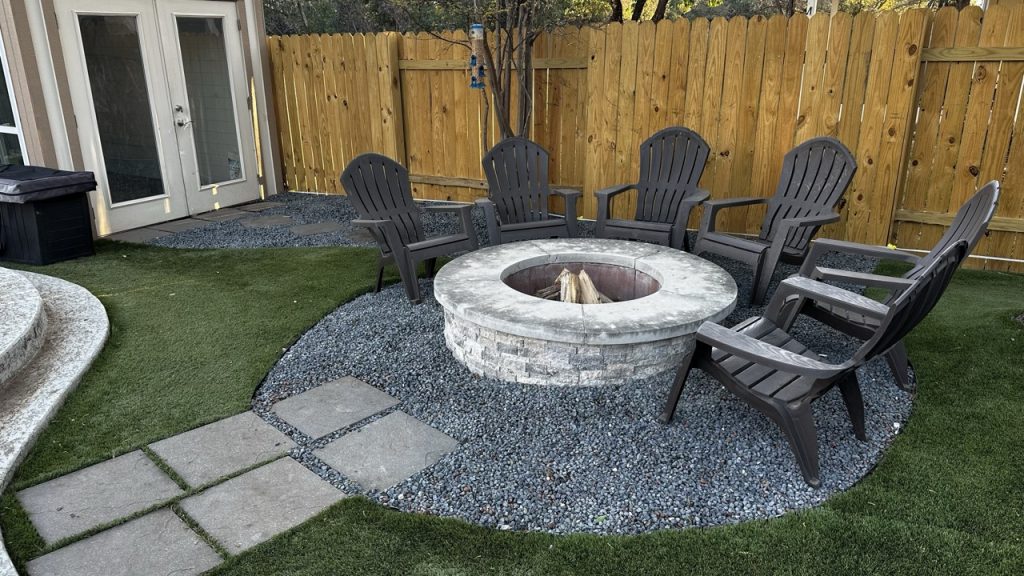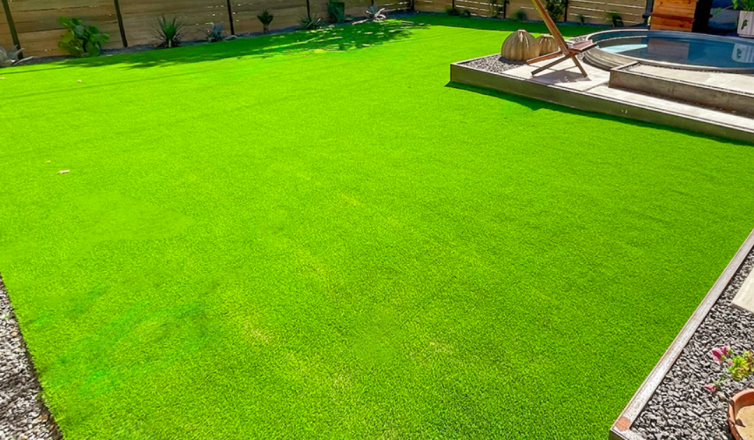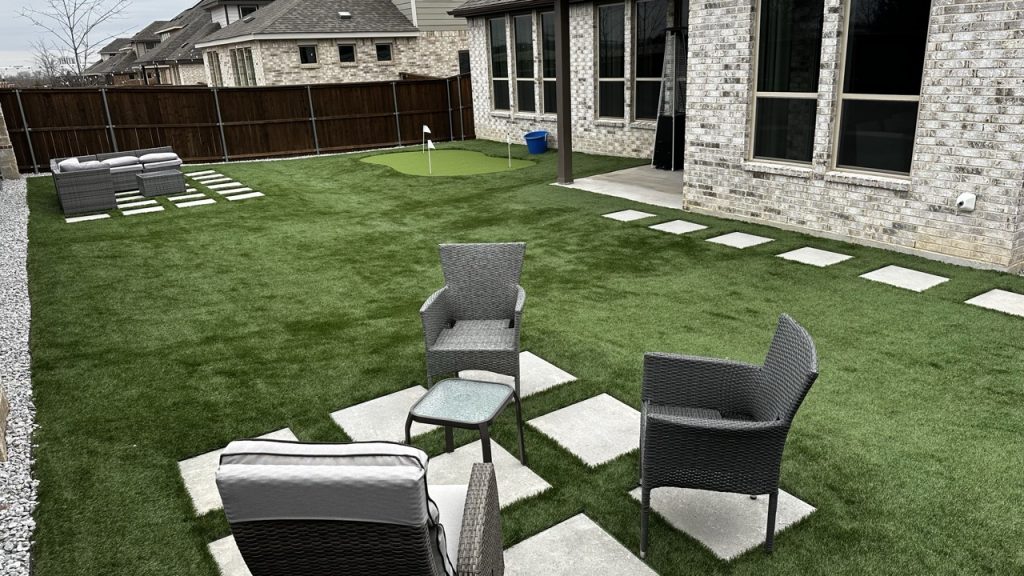Are you wondering, “Does artificial turf get hot?” Or maybe you’re worried about how synthetic grass stands up to pouring rain, mud, frost, or the relentless summer sun? You’re not alone. These are some of the most common questions we hear from homeowners and property managers across the South.
In this guide, you’ll get honest, practical answers about how artificial turf performs in every kind of weather. Whether you’re dealing with scorching heat, flash floods, bone-dry drought, or those rare winter chills, we’ll cover what you need to know so you can step onto your lawn with confidence, year-round.
Quick Summary
How Artificial Turf Handles Every Kind of Weather
- Does artificial turf get hot? Yes, turf can get warmer than natural grass in direct sun, but advanced materials and smart infill options help manage heat. Simple steps—like adding shade or a quick rinse with water—can make turf comfortable even on hot days.
- No mud, no mess: Properly installed turf stays clean and dry—no muddy footprints, soggy yards, or lingering odors after rain.
- No standing water: Turf won’t leave puddles or attract mosquitoes, keeping your yard usable and inviting right after storms.
- Perfect for drought and dry climates: Artificial grass stays green and lush without a drop of irrigation, making it an ideal choice where water is scarce.
- Stands up to cold: Turf won’t go dormant or patchy in winter. It handles frost and even the occasional southern snow, staying usable year-round.
- Safe for families and pets: Quality turf is designed to be safe for bare feet and paws—even in summer—with simple steps to keep it cool.
- Year-round curb appeal: Enjoy a great-looking yard with less hassle, no matter what Mother Nature has in store.
Does Artificial Turf Get Hot? Understanding Temperature
Does artificial turf get hot? It’s one of the first questions we hear, and it’s an important one for families, pet owners, and anyone who loves to walk barefoot outside.
Here’s the honest answer: Artificial turf can get warmer than natural grass on sunny days, sometimes by 10–30°F, especially in direct summer sunlight. But—here’s where it matters—turf still stays cooler than materials like concrete, asphalt, or pavers. On a blazing afternoon, natural grass might be around 85°F, turf could reach 110°F, and concrete can climb above 130°F.
Why does this happen? Unlike living grass, which naturally cools itself through evaporation, synthetic turf doesn’t release moisture and therefore can’t “sweat” away heat the way real plants do. The materials and color of artificial turf also make a difference; darker shades, traditional infills, and dense fibers can hold onto more warmth from the sun. Finally, your yard’s location matters—a lawn in full, direct sun will heat up more than areas with some shade.
How to Keep Your Artificial Turf Cool in Hot Weather:
- Create shady spots: Trees, pergolas, or shade sails are your turf’s best friends.
- Choose the right infill: Specialty cooling infills reduce heat absorption and help keep turf touchable.
- Rinse on extra-hot days: A few minutes with the hose brings turf temps down fast—a trick that works wonders before gatherings or pet playtime.
- Consider advanced turf tech: Some synthetic grasses are specifically engineered for heat reduction (ask us about your best options!).
The bottom line is that yes, artificial turf gets hot, but not dangerously so. With thoughtful design, the right installation and care, your lawn stays family- and pet-friendly even when the sun’s doing its worst.
How Turf Excels from Downpours to Drought
How Does Turf Handle Heavy Rain and Mud?
One of the biggest perks of artificial turf is how it handles wet weather. Unlike natural grass, which can quickly turn into a muddy mess after a downpour, properly installed turf stays clean and doesn’t get soggy. You won’t have to worry about mud being tracked indoors or onto your patio—and that makes a world of difference for busy families, pet owners, or anyone who loves spending time outdoors.
Another major advantage: Because artificial turf doesn’t retain water or moisture when installed correctly, you won’t experience the typical post-storm headaches. That means no lingering puddles, no standing water attracting mosquitoes, and no chance for mold, mildew, or musty odors to develop. Your yard remains safe, clean, and ready to enjoy almost immediately after the rain stops.
Does Artificial Turf Work in Naturally Dry Climates and Drought-Prone Areas?
Artificial turf truly shines in places where water is scarce or unpredictable. Thanks to its synthetic construction, turf stays green, lush, and dust-free, even through long stretches of dry weather and strict watering bans. There’s no worrying about brown patches, thinning grass, or creating dust clouds every time you step outside.
This makes artificial turf a practical and beautiful solution for regions facing water restrictions or frequent drought. You’ll save significantly on water bills and cut down on maintenance, keeping your outdoor space looking its best no matter what’s happening in the forecast.

Wintertime Ice, Frost, Snow, and Year-Round Turf Usability
While artificial turf is often associated with battling heat or dry weather, its performance is just as impressive when weather conditions swing to the other extreme. Many homeowners wonder: Will turf freeze, get slippery, or become unusable during cold snaps, frosts, or even those rare southern snowfalls?
How Does Turf Handle Frost and Ice?
Artificial turf won’t become patchy, dormant, or muddy in winter like real grass often does. When frost or a light dusting of snow lands on synthetic grass, it simply sits on top of the fibers. The yard may look a little frosty, but as temperatures rise, most of the moisture evaporates or runs off easily, without leaving puddles or bare spots.
Like any outdoor surface, artificial turf can be slick if covered with ice or a heavy frost. However, because turf does not hold moisture deep within, it typically thaws and dries faster than natural grass, especially in direct sunlight. As always, use caution with any icy outdoor surface, but rest assured that you won’t be dealing with a muddy mess once things warm back up.
Artificial Turf’s Year-Round Usability
One of the standout advantages of synthetic grass is its ability to look great and stay usable twelve months a year. No matter if it’s a chilly January morning or a blazing August afternoon, your yard remains green, mud-free, and ready for whatever the season throws its way. Neighbors may have brown, dormant patches, but your turf’s curb appeal never fades.
Pro Tips for Keeping Turf Comfortable in Extreme Weather
Want to get the most out of your artificial turf year-round? These practical tips will help your lawn stay comfortable, safe, and looking sharp no matter what Mother Nature brings:
- Keep turf cool in peak summer temperatures by giving it a quick hose down, adding shade with umbrellas or trees, and choosing advanced, light-colored infill.
- Effortlessly clean up after storms or freezing weather by brushing away debris with a broom or leaf blower and letting the sun dry out the surface.
- Before playtime with kids or pets, always check the turf with your hand to make sure it’s not too hot—just like you would with a sidewalk.
- Maintain your turf’s year-round good looks with regular rinsing, clearing of leaves or pet waste, and the occasional professional checkup.
With a few easy habits, your turf will deliver effortless enjoyment and stay as inviting as the day it was installed!
Artificial turf is built for Southern living—handling heat, rain, mud, cold snaps, and even the toughest drought with ease. No matter the season or the forecast, your yard stays green, clean, and ready for family fun, backyard barbecues, or a game of fetch with the pup.
Curious what turf could do for your home?
Get an instant estimate for your lawn by using the Lone Star Turf price calculator tool. Or, if you’d rather talk it through with a friendly expert, reach out for a free, no-pressure consultation. We’re always here to answer your questions, walk your property, and help you design a yard you’ll truly love—rain or shine.
Frequently Asked Questions (FAQ)
- Does artificial turf get hot compared to grass?
Yes, artificial turf can get warmer than natural grass in direct sunlight—sometimes 10–30°F hotter. However, with smart choices like light-colored infills, installing shade, or hosing down the lawn before use, you can keep your turf comfortable for bare feet, kids, and pets even on hot days. - Is artificial turf safe for kids or pets during summer?
Absolutely! Quality turf products are designed to be safe, non-toxic, and gentle. On very hot days, always test the surface with your hand or foot before letting children or pets play. Adding shade and using cooling infills make turf even more family-friendly in the summer. - How does turf hold up after heavy rain or flooding?
Artificial turf doesn’t retain water or stay soggy when installed properly. You won’t have to deal with mud, puddles, lingering odors, or standing water that attracts mosquitos. Your lawn will be ready to use shortly after the rain stops. - Will turf freeze or get slippery in winter?
Turf can become slick if there’s ice or heavy frost, like any outdoor surface. The good news: synthetic grass thaws and dries quickly, and it won’t turn patchy, dormant, or muddy during the winter months. - Is artificial turf good for dry climates and drought-prone areas?
Yes, turf is a perfect solution for naturally dry climates or drought-prone regions. It always stays green and lush—no watering, no brown patches, no dust—so your yard looks great all year, even during strict watering bans. - What can I do to keep my turf cooler in the summer?
You can keep turf cool by rinsing it with a hose before use, creating shaded areas, or asking your installer about advanced “cool” infill products designed to reflect sunlight. These steps are simple and highly effective for family comfort on hot days.
Want to learn more about artificial turf and how to keep it cool? Check out our Ultimate Guide to Artificial Turf.

